Evolution Law of Shallow Water in Multi-Face Mining Based on Partition Characteristics of Catastrophe Theory
Abstract
:1. Introduction
2. Main Control Factors of Instability Risk Assessment of Groundwater Systems
3. Risk Assessment of Shallow Water Instability Based on Catastrophe Theory
3.1. Normalization Process and Assessment Principle
3.2. Assessment Principle
- 1.
- Complementarity criterion: when analyzing the influence of each control variable on the state variable, if each variable can mutually make up for shortcomings, the membership degree is determined according to the average value of each control variable. Taking the dovetail catastrophe model as an example,
- 2.
- Non-complementary criterion: when analyzing the influence of each control variable on the state variable, if this influence cannot replace each other, or each other’s deficiencies cannot be mutually made up, the principle of “minimax” should be adopted for value selection, namely:
- 3.
- Over-threshold complementarity criterion: each control variable needs to be complementary after reaching a certain threshold.
3.3. Risk Analysis of Groundwater System Instability
4. Construction of Quantitative Assessment Model of Shallow Water Disturbance
4.1. Model Generalization
- Kx, Ky, Kz—Permeability coefficient in x, y, z directions (m/d)
- H—Elevation of groundwater level (m);
- t—Time (d);
- ε—Source item (1/d);
- Ss—Unit water storage coefficient of the water-bearing layer below free water surface (1/m);
- p—Precipitation infiltration and evaporation intensity (m/d);
- μ—Specific yield of aquifer;
- —External normal direction vector;
- q′—Class II boundary water inflow or outflow per unit area and per unit time (m/d);
- H0—t = 0 water level elevation (m);
- Ω—Scope of the simulator;
- Γ0—The upper boundary of the seepage area, that is, the free surface of groundwater;
- Γ1—Flow boundary of seepage area.
4.2. Verification of Quantitative Assessment Model of Shallow Water Disturbance
4.3. Evolution Law of Shallow Water in Multi-Working Face Mining Based on Catastrophe Theory Zoning
5. Discussion
6. Conclusions
- 1.
- Based on the connotation of water-retaining mining and the analysis of influencing factors of the water system, this paper determined the main influencing factors of shallow water in the Zhuan Longwan Coal Mine. They are the buried depth of the coal seam, the space distance between coal and water, the water abundance of the water-bearing medium, the permeability coefficient of the water-bearing medium, the thickness of the effective water-resisting layer, and the exploitation quantity. According to the characteristics of the research object, the large and small functions with semi-trapezoidal distribution were selected to normalize them.
- 2.
- According to the butterfly catastrophe model and cusp catastrophe model in catastrophe theory, the risk analysis of the Zhuan Longwan Coal Mine was carried out. The risk level of groundwater development was divided into five categories: small risk, light risk, middle risk, heavy risk and special risk.
- 3.
- According to the research results of the space-time evolution model of equivalent permeability coefficient, the quantitative assessment model of shallow water in the Zhuan longwan Coal Mine was established by adopting the numerical treatment method of water level geological parameters considering mining disturbance. Then, the redistribution characteristics of shallow water resources exploited in three consecutive working faces were simulated.
- 4.
- Under the condition of continuous mining of three working faces, mining had the most intense influence on the middle-risk area, followed by the light-risk area. The small risk area was the least disturbed. With the decrease in mining height, the influence range and degree of the shallow water in the study area gradually decreased. In the middle-risk area, the water level drop at measuring point 4 is the largest, 0.525 m, and that at measuring point 5 is the smallest, 0.116 m.
Author Contributions
Funding
Data Availability Statement
Acknowledgments
Conflicts of Interest
References
- Bai, E.H.; Guo, W.B.; Zhang, H.B.; Tan, Y.; Guo, M.J. In situ groundwater protection technology based on mining-conservation coordination in the middle and upper reaches of Yellow River Basin. J. China Coal Soc. 2021, 46, 907–914. [Google Scholar]
- Bian, Z.; Yu, H.; Lei, S.; Yin, D.; Zhu, G.; Mu, S.; Yang, D. Strategic consideration of exploitation on coal resources and its ecological restoration in the Yellow River Basin. China J. China Coal Soc. 2021, 46, 1378–1391. [Google Scholar]
- Miao, X.; Cui, X.; Xu, J. The height of fractured water-conducting zone in undermined rock strata. Eng. Geol. 2011, 120, 32–39. [Google Scholar] [CrossRef]
- Zhang, S. Mechanism of Shallow Water System Stability Control and Mine Area Planning Principle in Northwest Coalfields—Case Study Regarding Yushen Area. Ph.D. Thesis, China University of Mining and Technology, Beijing, China, 2021. [Google Scholar]
- Zhang, S.; Zhang, D.; Feng, G. Quantitative evaluation and planning method of shallow surface water response in multi-face mining—Case study regarding Zhuanlongwan coal mine. J. Clean. Prod. 2022, 373, 133830. [Google Scholar] [CrossRef]
- Wang, S.M.; Huang, Q.X.; Fan, L.M.; Yang, Z.Y.; Shen, T. Study on overburden aquclude and water protection mining regionazation in the ecological fragile mining area. J. China Coal Soc. 2010, 35, 7–14. [Google Scholar]
- Deng, N.D.; Yang, P.; Lin, P.X.; Li, F.; Lei, S.; Ma, F.; Zhou, Y.; Yuan, X. Study on zone chart of engineering geological conditions of protected water resources during coal mining in Yushen Mining Area. Coal Sci. Technol. 2017, 45, 167–174. [Google Scholar]
- Li, W.; Wang, Q.; Liu, S.; Wang, S. Grade types of water preserved coal mining coalmines in ecologically fragile area. J. China Coal Soc. 2019, 44, 718–726. [Google Scholar]
- Liu, S.; Li, W. Zoning and management of phreatic water resource conservation impacted by underground coal mining: A case study in arid and semiarid areas. J. Clean. Prod. 2019, 224, 677–685. [Google Scholar] [CrossRef]
- Chen, Y. Groundwater Movement and Resource Evaluation; China Architecture & Building Press: Beijing, China, 1986. [Google Scholar]
- Bear, J.; Bachmat, Y. Introduction to Modeling of Transport Phenomena in Porous Media; Springer Science & Business Media: Berlin/Heidelberg, Germany, 1990. [Google Scholar]
- Vafai, K. Handbook of Porous Media; CRC Press: Boca Raton, FL, USA, 2005; ISBN 0-415-87638-9. [Google Scholar]
- Mehl, S.; Hill, M.C. Development and evaluation of a local grid refinement method for block-centered finite-difference groundwater models using shared nodes. Adv. Water Resour. 2002, 25, 497–511. [Google Scholar] [CrossRef]
- Mazzia, A.; Putti, M. Mixed-finite element and finite volume discretization for heavy brine simulations in groundwater. J. Comput. Appl. Math. 2002, 147, 191–213. [Google Scholar] [CrossRef]
- Wu, Q.; Xu, H. Visual design environment for groundwater simulation. Comput. Eng. 2003, 29, 69–70. [Google Scholar]
- Wu, Q.; Jin, Y. Decision-Making System of Mine Water Prevention and Control in North China Coal Field; China Coal Industry Publishing House: Beijing, China, 1995. [Google Scholar]
- Fan, Z.L. Mining Safety Research of Thick Coal Seam under Aquifers and Surface Water in Nalinhe Mine Area; China University of Mining and Technology: Beijing, China, 2013; pp. 123–140. [Google Scholar]
- Hu, X.-J.; Li, W.-P.; Cao, D.-T.; Liu, M.-C. Index of multiple factors and expected height of fully mechanized water flowing fractured zone. J. China Coal Soc. 2012, 37, 613–620. [Google Scholar]
- Martin, D.; Sparrow, F.T. The treatment of uncertainty in mineral exploration and exploitation. Ann. Oper. Res. 1984, 2, 271–284. [Google Scholar] [CrossRef]
- Newman, C.; Agioutantis, Z.; Leon, G.B.J. Assessment of potential impacts to surface and subsurface water bodies due to longwall mining. Int. J. Min. Sci. Technol. 2017, 27, 57–64. [Google Scholar] [CrossRef]
- Zhang, G.; Wang, Z.; Guo, G.; Wei, W.; Wang, F.; Zhong, L.; Gong, Y. Study on Regional Strata Movement during Deep Mining of Erdos Coal Field and Its Control. Int. J. Environ. Res. Public Health 2022, 19, 14902. [Google Scholar] [CrossRef]
- Rathinasamy, V.; Mohamad, E.T.; Komoo, I.; Legiman, M.K.A.; Amaniyah, N.; Bhatawdekar, R.M.; Hanapi, M.N.B.; Suparmanto, E.K.B. Fracture Characterization Using Downhole Camera in Deep Boreholes at Southern Johor Bahru, Malaysia. In Proceedings of the International Conference on Geotechnical Challenges in Mining, Tunneling and Underground Structures, ICGMTU 2021, Virtual, 20–21 December 2021; Springer Science and Business Media Deutschland GmbH: Berlin/Heidelberg, Germany, 2022; Volume 228, pp. 183–197. [Google Scholar]
- Pan, Y.; Wang, Z.Q.; Zhang, Y. Application of Catastrophe Theory to Dynamic Instability of Rock Mass System; Science Press: Beijing, China, 2008. [Google Scholar]
- Dammak, F.; Baccour, L.; Alimi, A.M. An exhaustive study of possibility measures of interval-valued intuitionistic fuzzy sets and application to multicriteria decision making. Adv. Fuzzy Syst. 2016, 2016, 9185706. [Google Scholar] [CrossRef]
- Xu, G. Theory and Numerical Simulation of Underground Fluid Seepage; Geological Publishing House: Bath, UK, 2008; ISBN 7-116-05876-1. [Google Scholar]
- Hydrological Bureau of the Ministry of Water Resources and Hydropower. Evaluation of Water Resources in China; Chinese Iirrigation Works and Water and Electricity Press: Beijing, China, 1987. [Google Scholar]
- Survey, C.G. Handbook of Hydrogeology; Geological Publishing House: Beijing, China, 2012. [Google Scholar]
- Wang, X.; Zhang, J.; Liu, J.; Wang, G.; He, R.; Wang, Y.; Zhang, M.; Liu, C. Water demand management instead of water supply management: A case study of Yulin City in northwestern China. In Proceedings of the Improving Integrated Surface and Groundwater Resources Management in A Vulnerable and Changing World, Proceedings Symposium JS. 3 at the Joint Convention of the International Association of Hydrological Sciences (IAHS) and the International Associaiton of Hydrogeologists (IAH), Hyderabad, India, 6–12 September 2009; IAHS Press: Wallingford, UK, 2009; pp. 340–346. [Google Scholar]
- Lockwood, J.A.; Lockwood, D.R. Catastrophe theory: A unified paradigm for rangeland ecosystem dynamics. Rangel. Ecol. Manag. Range Manag. Arch. 1993, 46, 282–288. [Google Scholar] [CrossRef]
- Yan, H. Study on evaluation of land resources carrying status in Fujian province. Territ. Nat. Resour. Study 2019, 1–5. [Google Scholar] [CrossRef]
- Wang, X.-J.; Zhang, J.Y.; Shamsuddin, S.; Xia, X.-H.; He, R.-M.; Shang, M.-T. Catastrophe theory to assess water security and adaptation strategy in the context of environmental change. Mitig. Adapt. Strateg. Glob. Chang. 2014, 19, 463–477. [Google Scholar]
- Xiao, Y.; Tian, K.; Yuan, M.; Ouyang, Y.; Huang, H. Examining the complex relationships between socioeconomic development and the improvement of ecological environment in post-disaster reconstruction: The case of Wenchuan earthquake disaster area in Western China. J. Clean. Prod. 2022, 337, 130581. [Google Scholar] [CrossRef]
- Sarwar, A.; Eggers, H. Development of a conjunctive use model to evaluate alternative management options for surface and groundwater resources. Hydrogeol. J. 2006, 14, 1676–1687. [Google Scholar] [CrossRef]
- Noll, W.; Coleman, B.D.; Noll, W. The thermodynamics of elastic materials with heat conduction and viscosity. In The Foundations of Mechanics and Thermodynamics: Selected Papers; Springer: Berlin/Heidelberg, Germany, 1974; pp. 145–156. [Google Scholar]
- Wasko, C.D.; Timms, W.A.; Miller, B.M. Groundwater modelling in a highly seasonal, fractured rock environment using FEFLOW. In Proceedings of the 34th World Congress of the International Association for Hydro-Environment Research and Engineering: 33rd Hydrology and Water Resources Symposium and 10th Conference on Hydraulics in Water Engineering; Engineers, Barton, Australia, 26 June–1 July 2011; pp. 1709–1716. [Google Scholar]
- Zhao, C.; Wang, Y.; Chen, X.I.; Li, B. Simulation of the effects of groundwater level on vegetation change by combining FEFLOW software. Ecol. Model. 2005, 187, 341–351. [Google Scholar] [CrossRef]
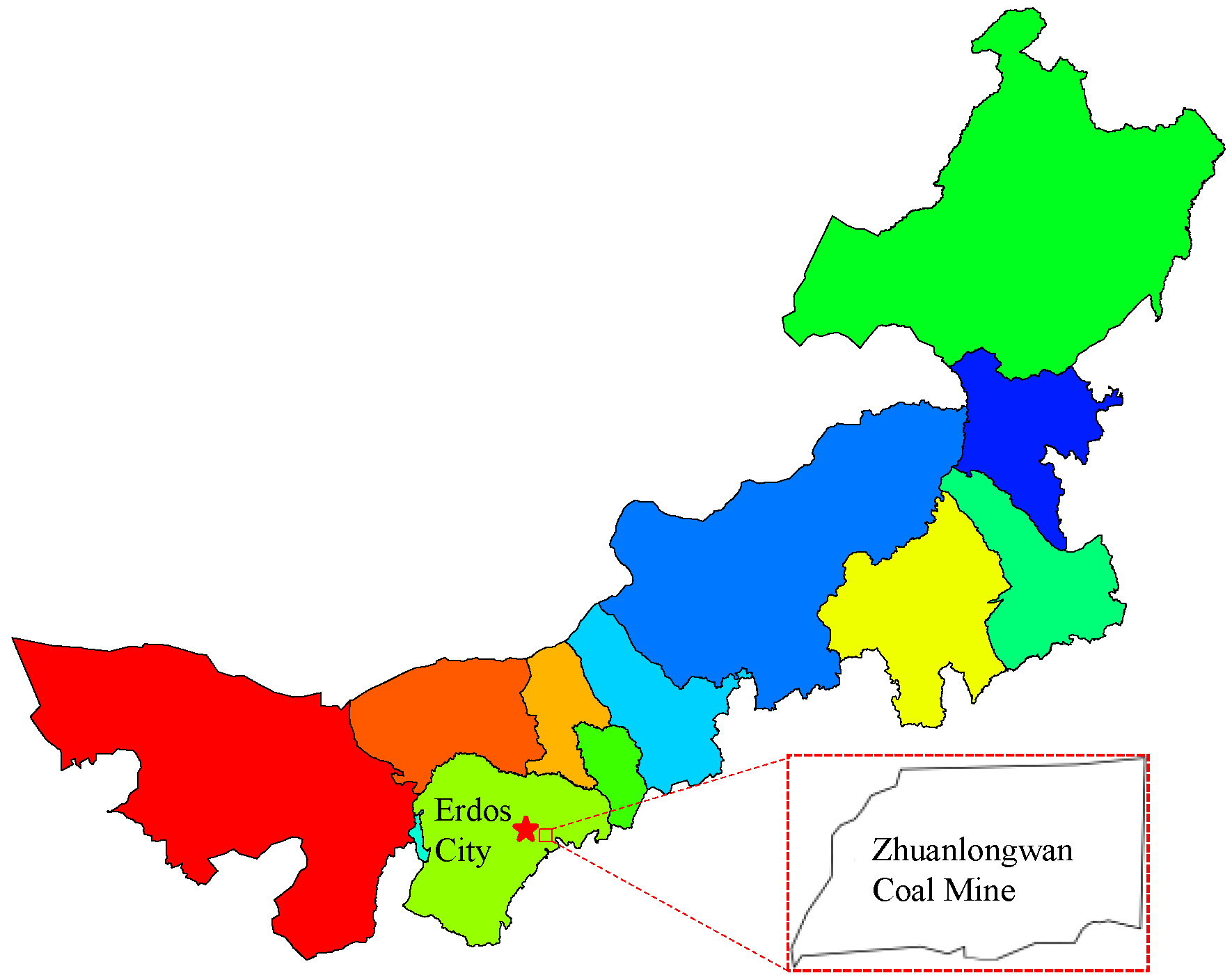



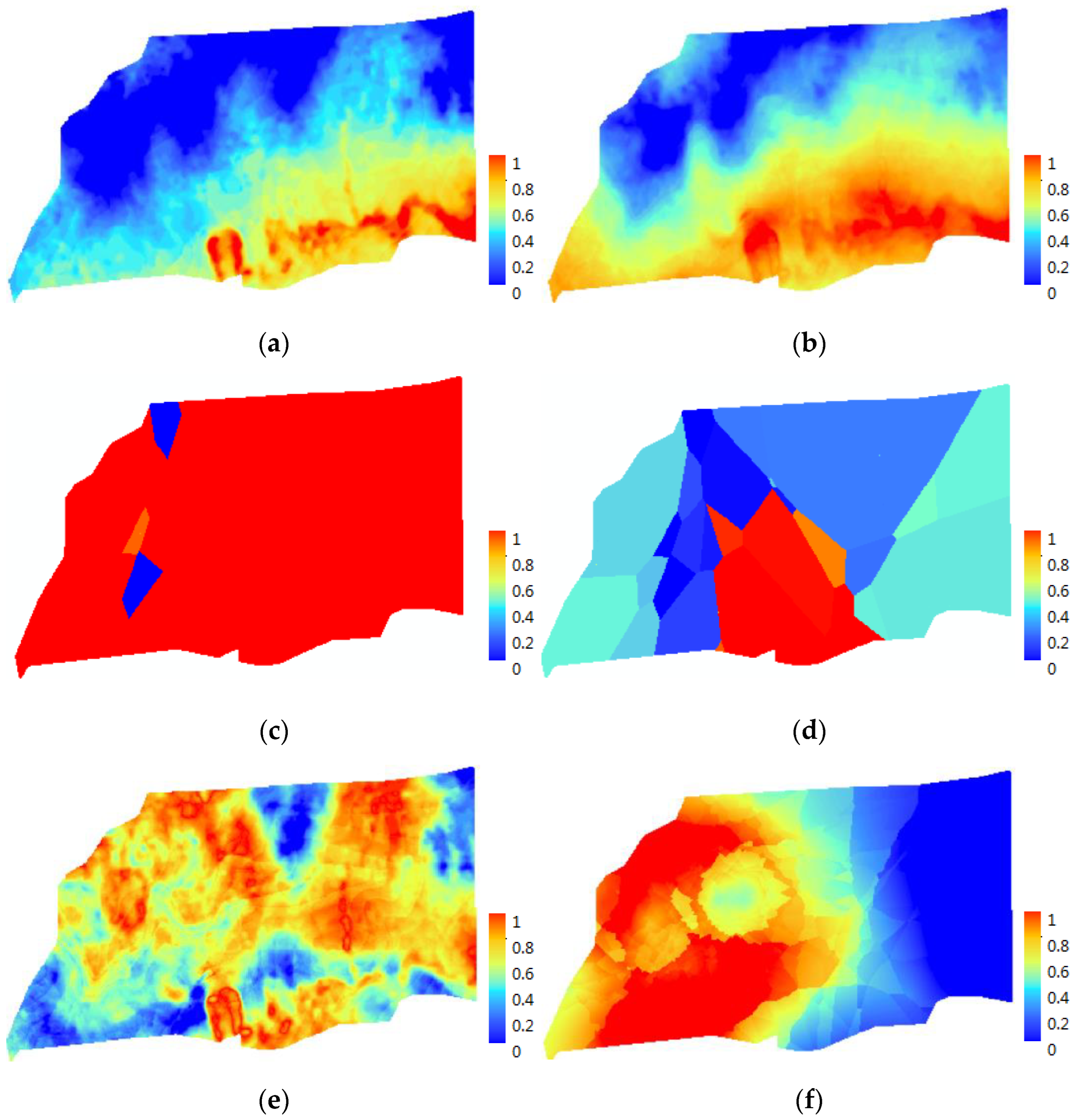

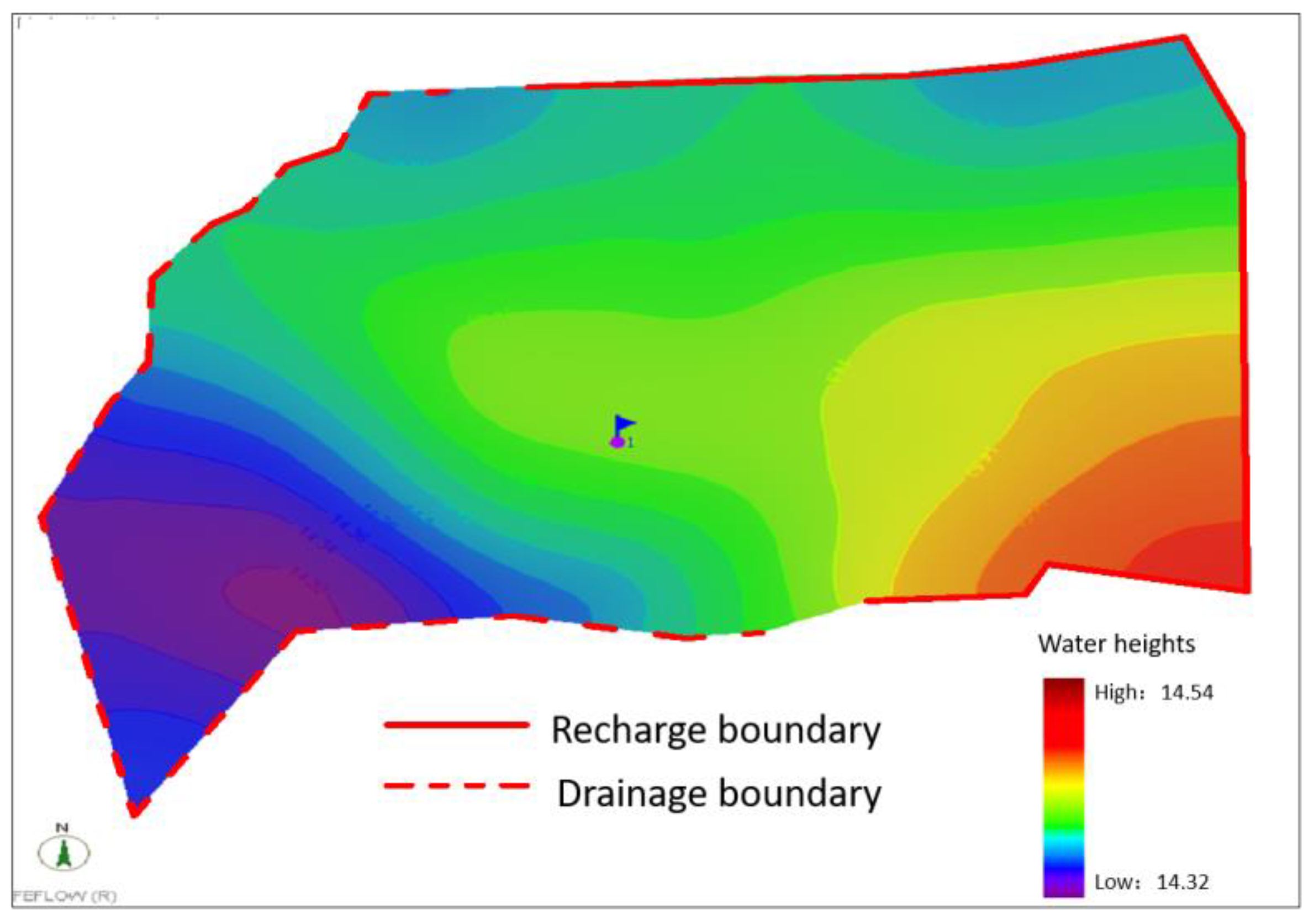
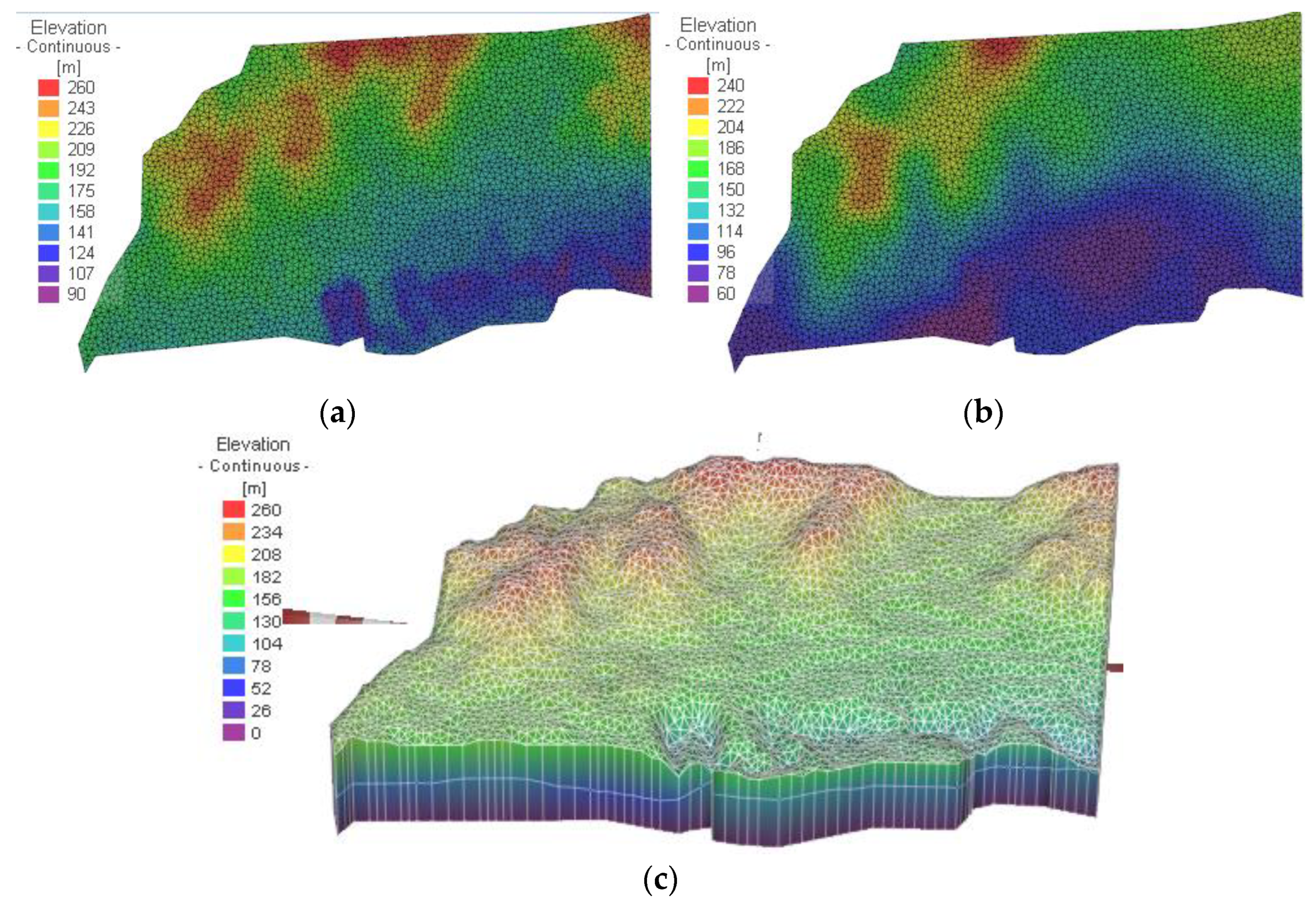
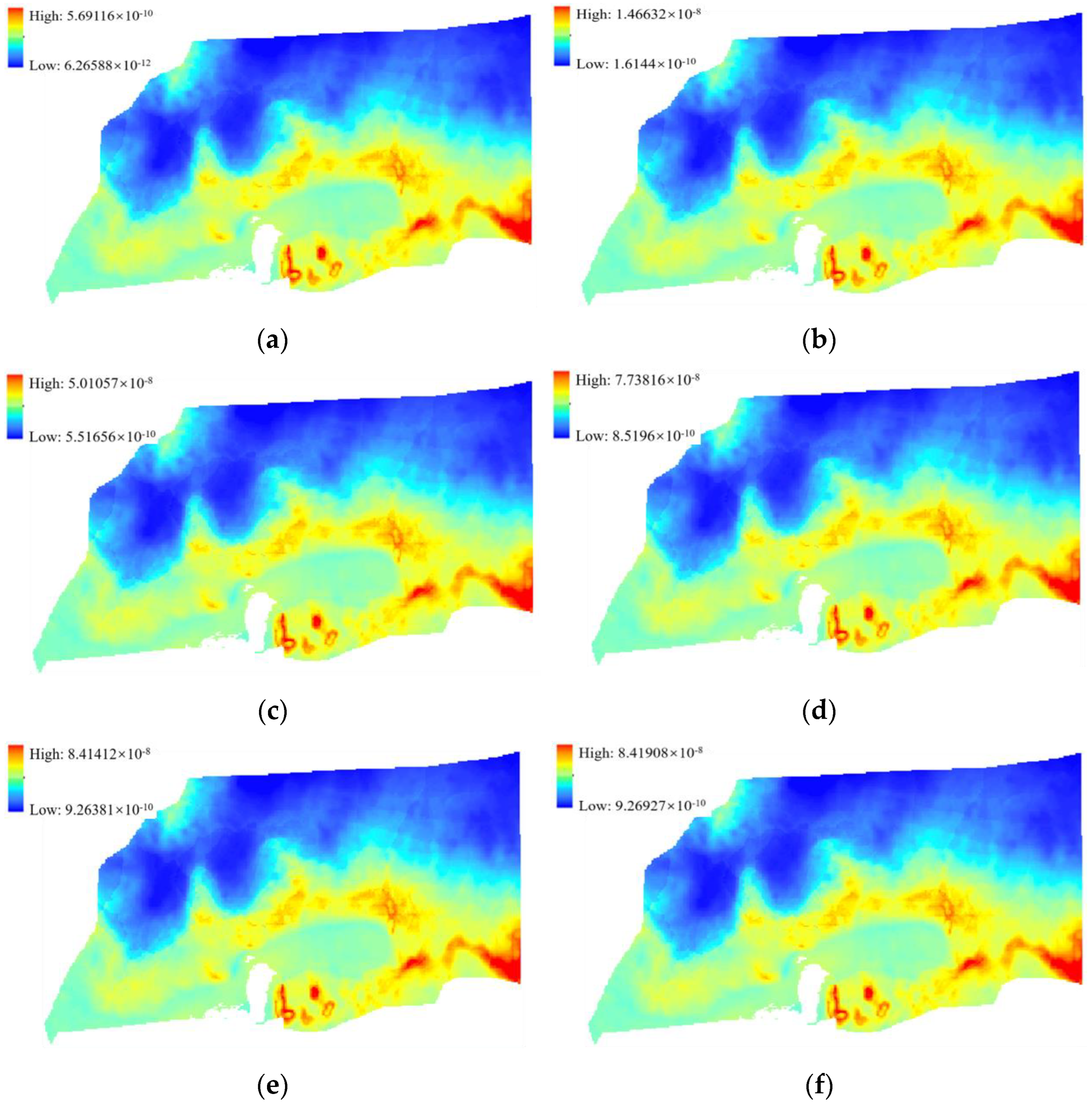
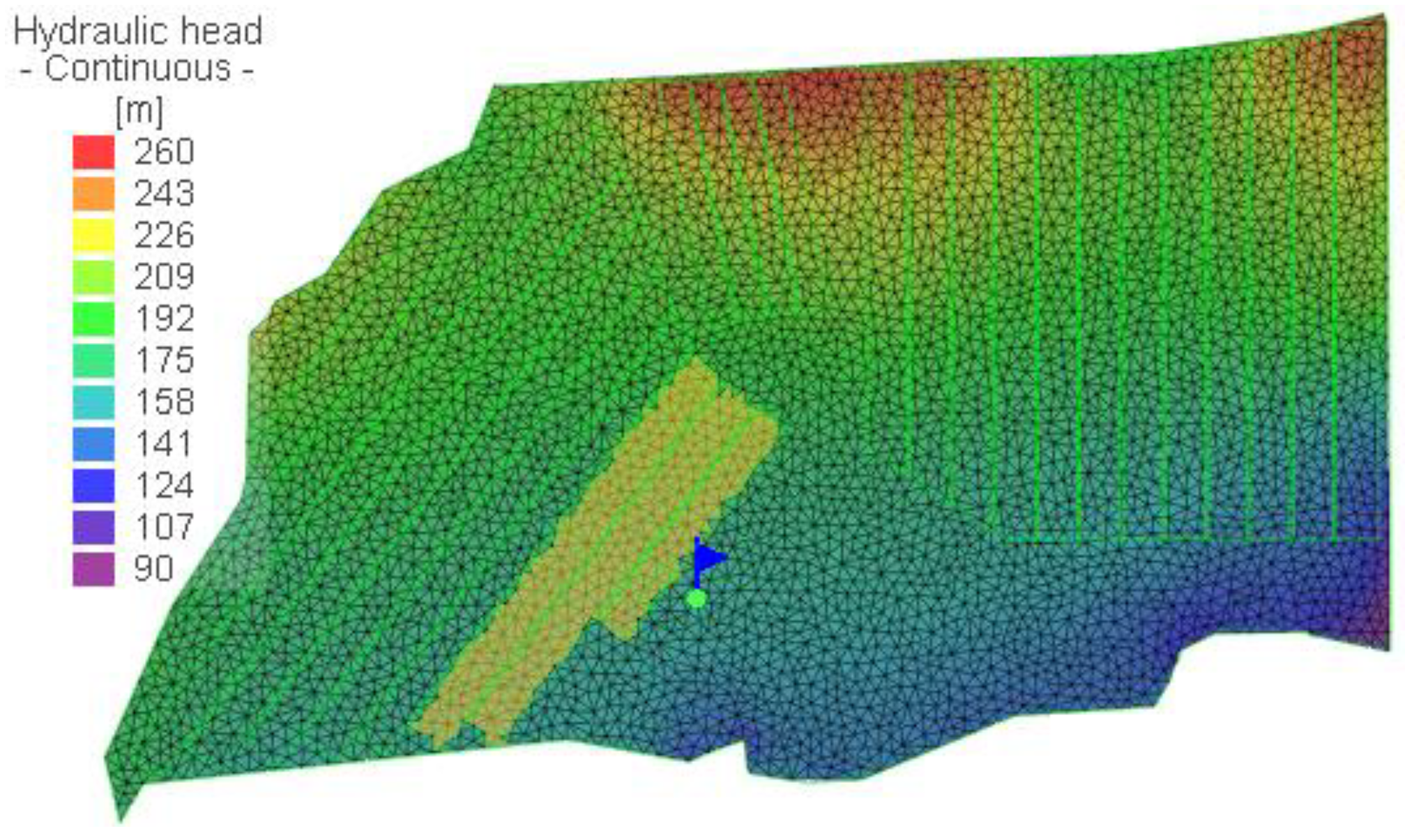


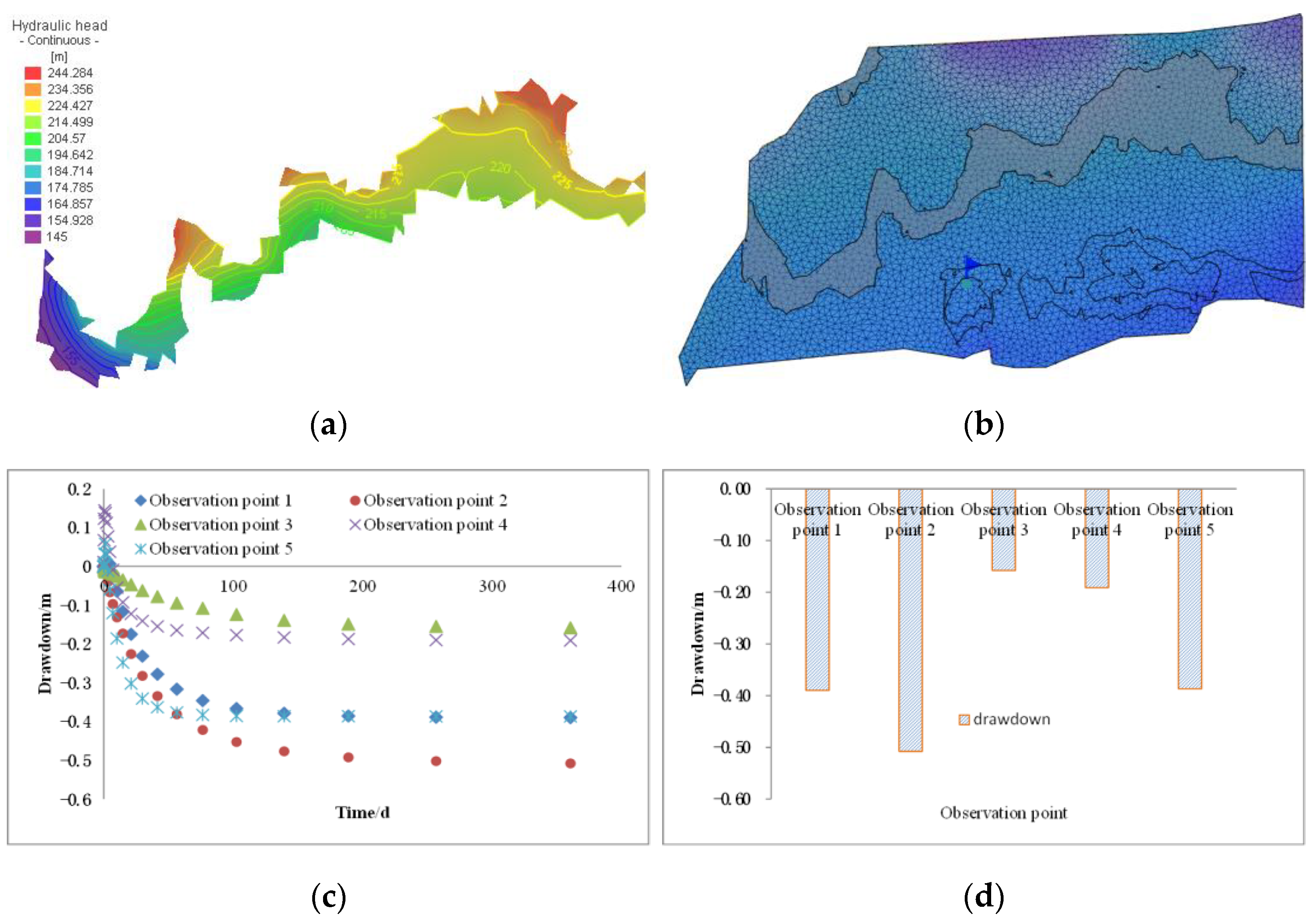
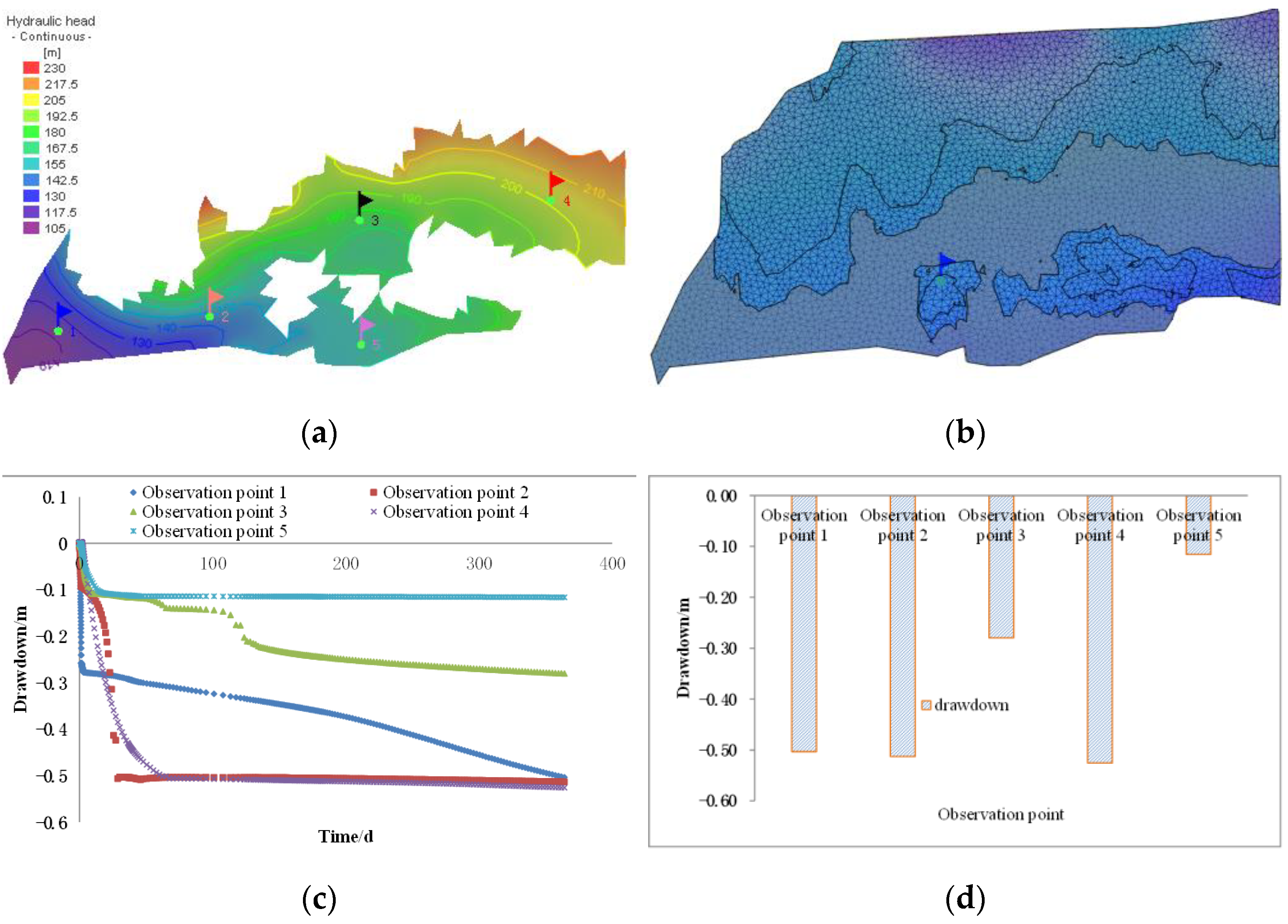
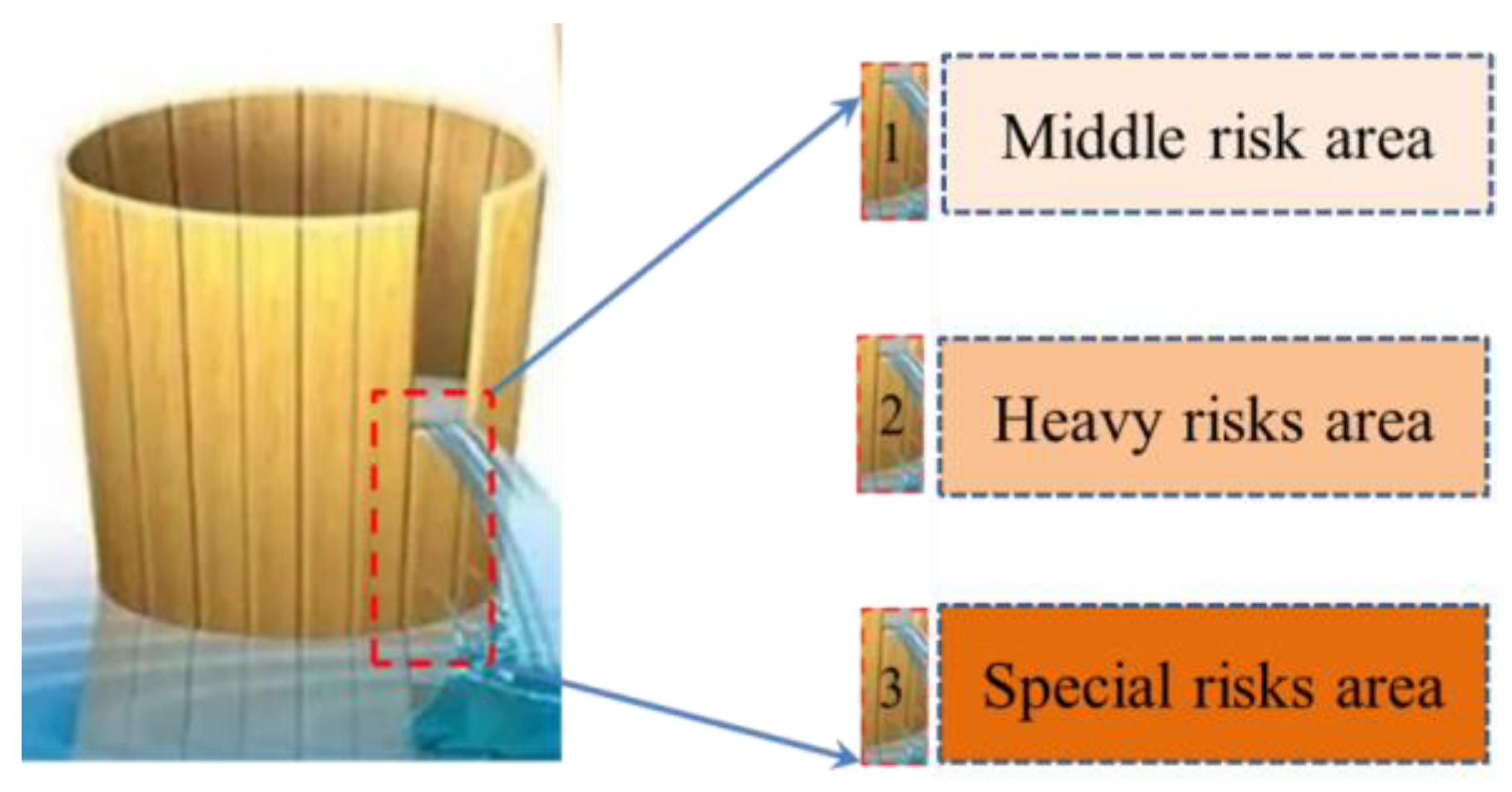
| Grade | Special-Risk Area | Heavy-Risk Area | Middle-Risk Area | Light-Risk Area | Small-Risk Area |
|---|---|---|---|---|---|
| Risk value | R ≥ 0.95 | 0.95 ≥ R ≥ 0.85 | 0.85 ≥ R ≥ 0.50 | 0.50 ≥ R ≥ 0.30 | R ≤ 0.30 |
| Rock Stratum Name | Permeability Coefficient (m/d) | Average Permeability Coefficient (Kx/y) | Average Permeability Coefficient (Kz) | Water Storage Coefficient Ss (1/m) | Specific Yield (μ) | Rainfall Infiltration Coefficient |
|---|---|---|---|---|---|---|
| 1—water-bearing layer | 0.0599–8.433 | 5.42375 | 0.542375 | 2.0 × 10−2 | 0.25 | 0.2 |
| 2—water-resisting layer | 0.0083–0.21 | 0.0025 | 0.00025 | 1.2 × 10−3 | 0.125 | / |
| 3—Water-blocking layer | / | 0.00067 | 0.000067 | 1.8 × 10−6 | 0.020 | / |
Disclaimer/Publisher’s Note: The statements, opinions and data contained in all publications are solely those of the individual author(s) and contributor(s) and not of MDPI and/or the editor(s). MDPI and/or the editor(s) disclaim responsibility for any injury to people or property resulting from any ideas, methods, instructions or products referred to in the content. |
© 2023 by the authors. Licensee MDPI, Basel, Switzerland. This article is an open access article distributed under the terms and conditions of the Creative Commons Attribution (CC BY) license (https://creativecommons.org/licenses/by/4.0/).
Share and Cite
Zhang, Y.; Cui, B.; Wang, Y.; Zhang, S.; Feng, G.; Zhang, Z. Evolution Law of Shallow Water in Multi-Face Mining Based on Partition Characteristics of Catastrophe Theory. Fractal Fract. 2023, 7, 779. https://doi.org/10.3390/fractalfract7110779
Zhang Y, Cui B, Wang Y, Zhang S, Feng G, Zhang Z. Evolution Law of Shallow Water in Multi-Face Mining Based on Partition Characteristics of Catastrophe Theory. Fractal and Fractional. 2023; 7(11):779. https://doi.org/10.3390/fractalfract7110779
Chicago/Turabian StyleZhang, Yujiang, Bingyuan Cui, Yining Wang, Shuai Zhang, Guorui Feng, and Zhengjun Zhang. 2023. "Evolution Law of Shallow Water in Multi-Face Mining Based on Partition Characteristics of Catastrophe Theory" Fractal and Fractional 7, no. 11: 779. https://doi.org/10.3390/fractalfract7110779
APA StyleZhang, Y., Cui, B., Wang, Y., Zhang, S., Feng, G., & Zhang, Z. (2023). Evolution Law of Shallow Water in Multi-Face Mining Based on Partition Characteristics of Catastrophe Theory. Fractal and Fractional, 7(11), 779. https://doi.org/10.3390/fractalfract7110779






